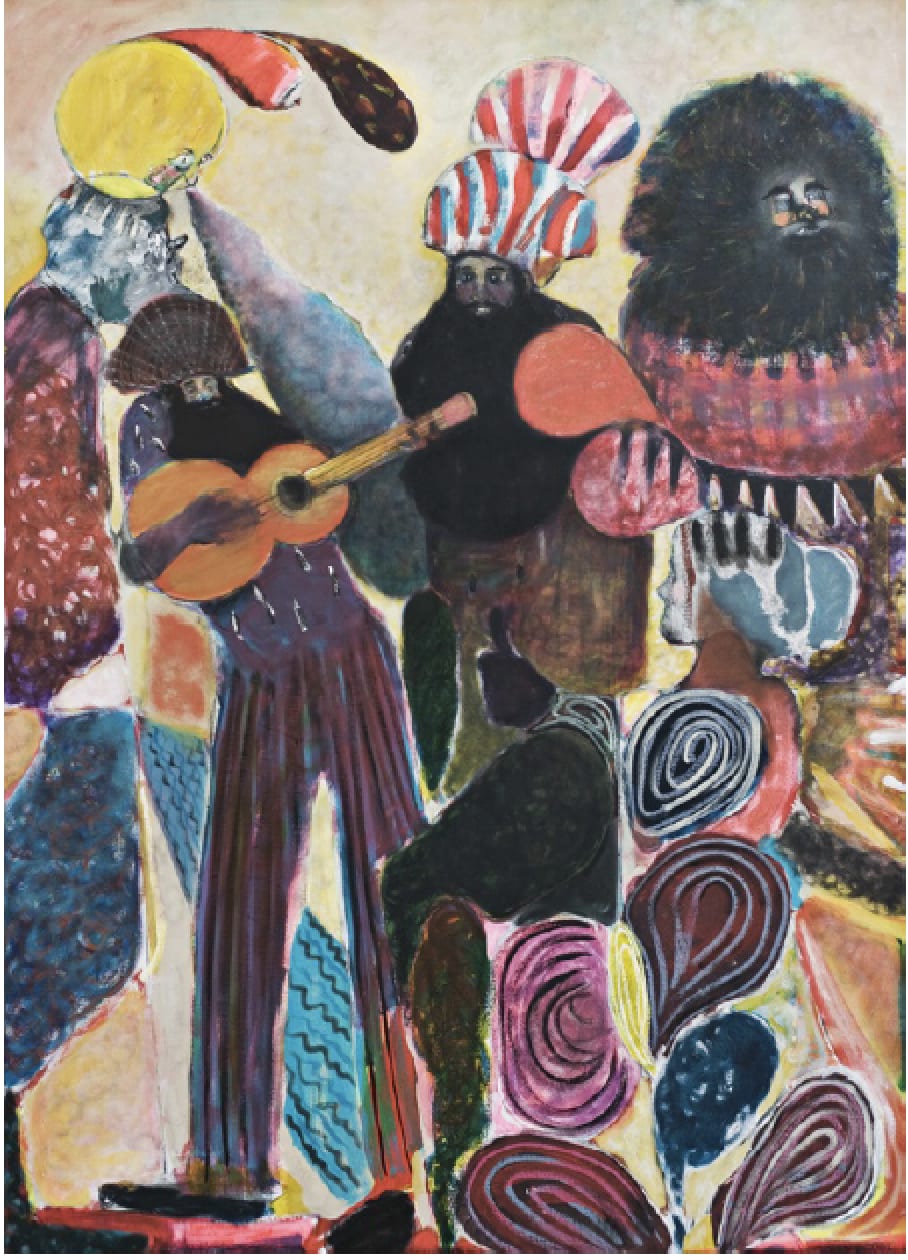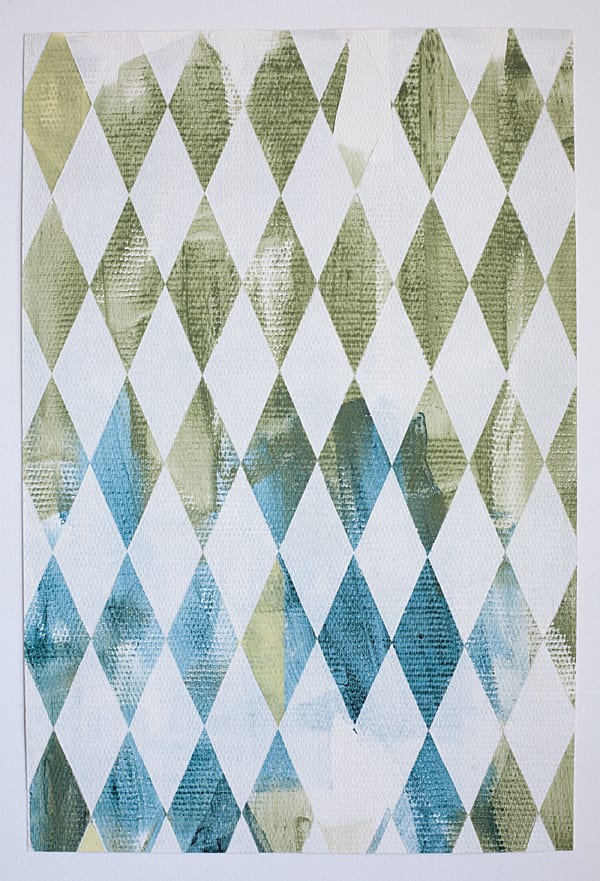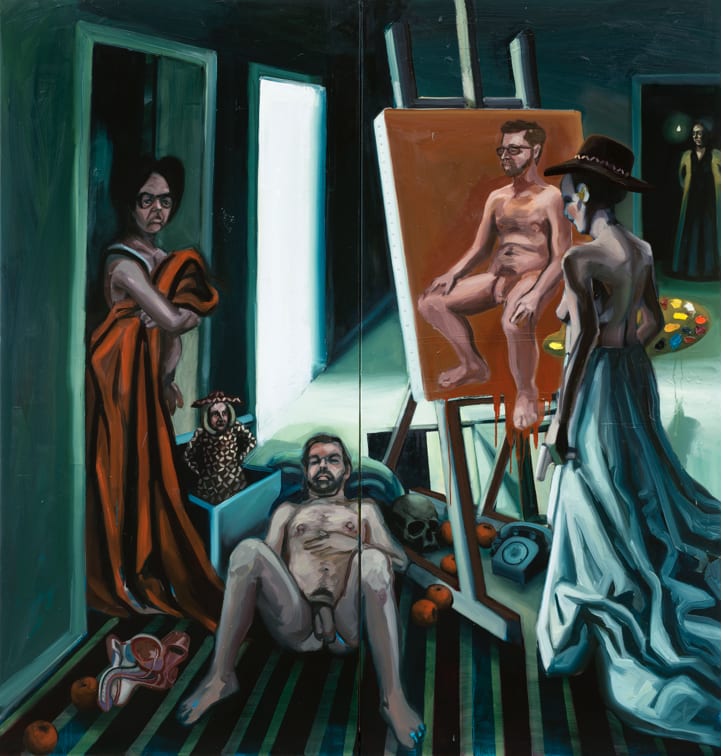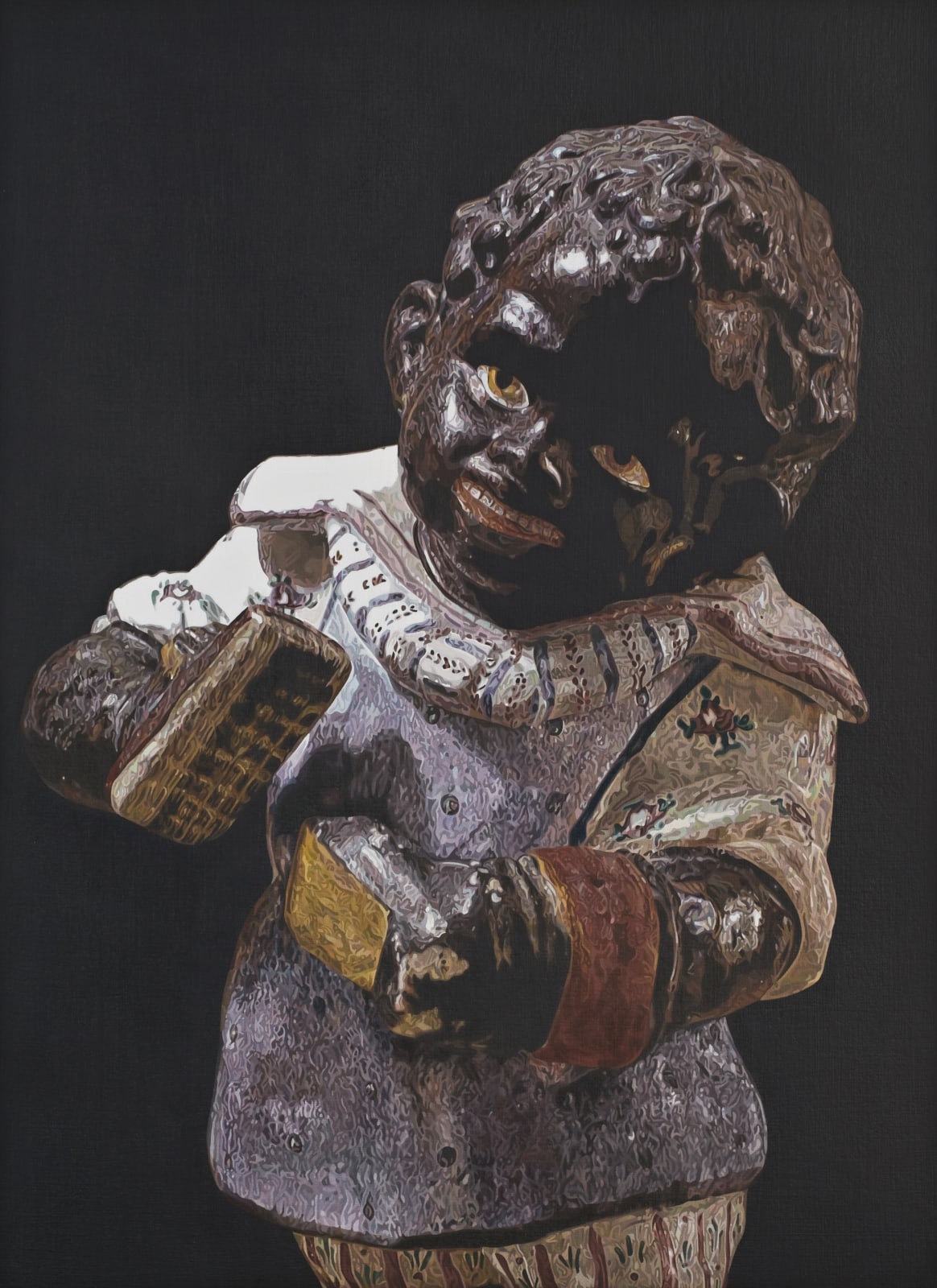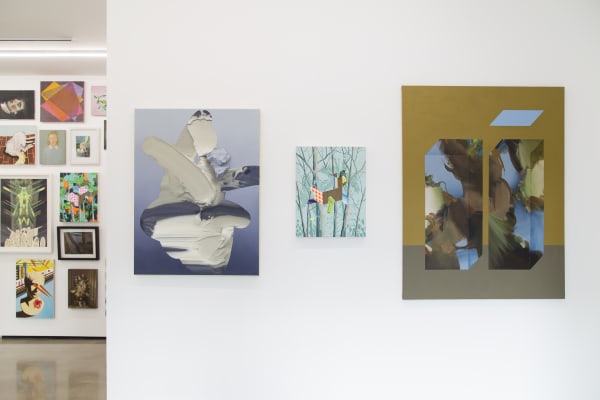100 PAINTERS OF TOMORROW: LONDON
BEERS London is extremely proud to announce the official release of a major publication, entitled, 100 Painters of Tomorrow. Authored by Director Kurt Beers and published by the UK’s leading fine art publishers, Thames & Hudson, this unique and special publication is the culmination of an extensive project to find the most exciting, fresh and up-and-coming emerging painters currently at work worldwide. The book is an intelligent, wide-ranging and exhilarating survey of largely unknown talent, selected by a distinguished international panel including: painter Cecily Brown; Director of London’s Institute of Contemporary Arts, Gregor Muir; Head of Sharjah Biennale, Yuko Hasegawa, author of PHAIDON’s Painting Today, Tony Godfrey; and author of PHAIDON’s Vitamin P (Eds. I & II), Barry Schwabsky among others.
The 100 artists featured therein were gathered via an international open-call for submissions that drew over 4,300 applications from 37 countries including Argentina, Belgium, Brazil, Canada, China, Germany, India, Iran, Japan, Mexico, Poland, Singapore, South Africa, Turkey, the UK and the USA.
To celebrate the release of 100 Painters of Tomorrow – a project that has been 2 years in the making – Kurt Beers and the entire team at BEERS London is thrilled to be collaborating with these talented and internationally-based painters with exhibitions in London and New York. 100 Painters of Tomorrow (London/New York) showcases a unique cross-section of painting from artists included in the publication that spans an extraordinary range of styles and techniques; abstraction to figuration, minimalism to magical realism, traditional oil-on-canvas and mixed media, to performance and installation-based painting.
Exhibiting together for the first time, the work of these artists (who range in age from 23-64) offers an intriguing insight into the state of painting today by providing personal insight into the thinking and creative practices of the 100 artists included therein.
JULIETA AGUINACO
Mexican painter Julieta Aguinaco (b. 1983) is interested in time, or, more specifically, the universal and constant change that occurs beyond the lifespan of humans. Her work draws great inspiration from the theoretical writings of French historian and sociologist Fernand Braudel, who classifies time into three categories: Biological, corresponding to the duration of a human life (in decades), Historical, in which one or more generations make history (in centuries,) and finally, Geological, the one in which mountains move, climates change, and evolution makes species transform (in millenniums). For Aguinaco, the painterly exploration of each type of time is of tantamount importance to her work. The paintings appear like stratospheric/geological cross-sections, often populated with minute imagery of contemporary society: industrial smokestacks and power-plants, traces of architecture, infrastructure, and even what appear to mimic primitive-like cave drawings. She states: “My context, in Mexico City, Mexico, its place in Earth, is now a threatened world: from the problems of climate change to the numerous political conflicts throughout the globe is chaotic and even frightening. I don’t mean to suggest a fatalistic view of the world, but these are complex times, and my paintings intend to portray the spirit of the moment within which we are living: the micro-universe of a local or personal history, to the macro-universe of Earth and its periods, when the idea of progress dies and the idea of fragility and catastrophe is born. To simply think about time, to try to understand it and to try to represent it, is my main sources of inspirations, and painting is a medium of infinite possibilities within its own restrained boundaries, and even such boundaries can be changed, broken, or trespassed.”
CHECHU ALAVA
There is something undeniably subtle and stirring in the works of Spanish artist Chechu Alava (b. 1973). Working out of Paris, Alava’s paintings elicit a quiet reflection on the nature of femininity and identity. After earning a BFA in painting from the University of Salamaca (Spain) in 1996, Alava delved into her artistic practice as a means of attaining a more intimate understanding of the value of beauty. With softened lines, a generally blurred appearance, and muted palette, her portraits take on the timeless feel of beloved old photographs lifted from literary, artistic, and even political histories. The paintings present their female subjects in traditional poses, reflecting an appreciation for art historical precedent. Accordingly, she finds inspiration in the work of masters such as Velázquez, Tintoretto, and Goya, but her variation of these predecessors is noticeable, even (if art may appear feminine) taking a feminist perspective that begs retelling. Perhaps the reflection on femininity within her paintings more tellingly recalls the work of Mary Cassat, another major influence on Alava’s practice, both of whom seem to focus on the domesticity and private, unremarkable moments of the female subjects they depict. However Alava does not defer to art history alone, and her selection of portrait subjects includes Ingrid Bergman, Simone de Beauvoir, Sylvia Plath and even Frida Kahlo…at age five. It is a tricky, perhaps pejorative task: to explore the mystery and austerity of beauty, a process that indeed prompts the viewer to reconsider the norms of representations of femininity. The viewer never doubts that Alava’s subjects are beautiful, but even as we appreciate their beauty, we are led to question the meaning and function of this aesthetic preconception with a sense of caution, as so many of her subjects meet our gaze, with a knowing, almost quiet defiance.
KRISTINA ALISAUSKAITE
The imagery of dreams is often understood as an uncontrolled cognitive reprocessing of the same images we encounter, even subconsciously in real life. And while for the most part, dreams and reality are considered mutually exclusive entities, Lithuanian artist Kristina Alisauskaite’s (b. 1984) attempts to question this theory through her painting practice. Executed in a palette usually restricted to black and white, Alisauskaite’s unsettling scenes typically remove many telling details, leaving ghostlike traces and mere suggestions of the images that are depicted. For Alisauskaite, such a presentation mirrors the atmospheric quality of dreams; which for her, allows complete unrestricted access to the psyche. Considered in this regard, it seems as though Alisauskaite’s paintings tell her what to explore, rather than the artist directing this herself. She references Freud and Jung in their theories of the subconscious, but maintains that her perspective is detached from psychoanalysis, and rather, aims to converse with the viewer through familiar, even banal scenes. Coded with symbols and metaphors, the works evoke an intimacy that seems uncertain, even private, inviting the viewer to quietly participate in the unsettling scenes depicted.
MICHAEL ARMITAGE
A 2010 postgraduate of the Royal Academy of Arts in London, Kenyan-born artist Michael Armitage’s (b. 1984) practice is concerned with East African development and its inevitable effects on traditions and culture. Notably, the works are painted on Lubogo Bark paper; taken from the Lubogo tree in its native Uganda, the paper is selectively known to be perhaps the earth’s most sustainable fabric. His series of paintings titled Peace Coma refers to the tensions surrounding Kenyan elections in March 2013, in which NGOs coined the phrase as a descriptor of the public’s unwillingness to criticize election results. Armitage uses painting as a method for reviewing images that question and reflect cultural and political development on both a local and international stage. “I have been thinking about the way that development is having an effect on culture in Kenya as older forms of cultural identity are threatened. What are we left with and how do we represent our selves?” Armitage lists the following example, where a ‘parody’ of the traditional of the Maasai hunting dance is performed for tourists or politicians. The ramifications of such parody on both culture and representation are significant on culture as they are on Armitage’s practice. He believes this simulacra is crucial to the understanding of his work, and also how ‘the tropics’ have been defined through the history of painting (he lists Gauguin, Kirchner, Rousseau, and Doig) and is keenly aware of his saccharine and nostalgically familiar palette of pinks, yellows, and cool greens accentuated by bright flashes of colour, a palette that seems remarkably familiar given the subject matter (and equally typical of those aforementioned artists). “Perhaps the way we look at these types of painted images has the same effect on the culture as does the Moran, continually performing his hunting dance for the tourists?”
CORNELIA BALTES
“My works are playful investigations,” says German artist Cornelia Baltes (b. 1978). Viewing the context of painting as one element in a wider arsenal of tools, she treats each components of her work as significant to the understanding of the whole composition. For instance, stretcher bars occasionally peek out from behind the hierarchical canvas, as seen in Dingbats. In Deep Thought, the notion of material hierarchy or even importance is further negated as Baltes cuts into the canvas to reveal the supporting wall. In doing so, she shifts the nature of the artwork and considers the painting as installation and an object within an environment. Similarly, in Girl with a Pearl Earring, the viewer is pulled into a greater art historical context to question the motive and source of the artwork, as well as its relationship to its current placement in space and time: less a painting, more an installation, or perhaps a conceptual artwork. Throughout her practice the idea of space is delineated to lesser or greater degrees, and a sense of context and humour seems to prevail in so doing. “I try to capture the essence of an idea, a simple beauty.” Baltes states. “I guess there is also an ironic nod towards heroic formalism in my work.” While she works in a number of different media, Baltes believes it is the directness of paint that trumps all others. It is perhaps this immediacy and historic context through which we unearth different meanings in her work, sometimes silly, sometimes thoughtful, but always responsible to the sheer tangibility of the object and the messages created therein.
AGLAE BASSENS
A duality exists in representational art between the object being represented, and its artistic interpretation; that is to say how an object appears, and how the artist chooses to depict that object are not necessarily one and the same. Belgian born, London based painter Aglae Bassens (b. 1986), chooses to situate her practice somewhere within this dichotomy, creating work that explores these corners of difference. She believes this duality is something inherent in the medium of painting itself, where the artist’s subjectivity and physicality inevitably alters each attempt with the medium. Perhaps it is for the purpose of unearthing these minute differences that her paintings feature so much repetition: rows of wigs in various colours, the legs of synchronized swimmers bent akimbo like folds of origami; the texture of water, or hair, embellishing a figure. However, perhaps Bassens’ approach to painting is less informed by her subject matter and more about her sheer love for the medium, as her process allows her to study the differences that occur, through repetition, in her very process of translating the medium from raw material to image. She believes it demonstrates the transformative power of paint, where an artist might more beyond a realm of the aesthetic to actually offer insight to the conceptual tendencies present within the actions of the artist herself, as evidenced through paint, and back again.
EMMA BENNETT
The presence of death is an unavoidable aspect of life, and for centuries artists have interacted with this sobering concept through their work. For British artist Emma Bennett (b. 1974), the act of painting presents the opportunity for a unique understanding of death and the effects of time. Educated at the Chelsea College of Art and Design (MA 2008) and currently based in London, Bennett’s paintings almost always follow the same method: still-life compositions set against deep black backdrops that appear both as painstaking homages to a tradition of still life while somehow managing to maintain a sense of urgent modernity. Drawing inspiration most notably from the 17th century Dutch Masters, Bennet also culls inspiration from a legacy of Baroque floral painters such Rachel Ruysch, and appropriates imagery from the Italian Renaissance and even from a diverse array sources more tellingly related to the technical mastery of her skill, such as photography and film. Yet despite their stark, cinematic qualities and hyperrealist appearance, Bennett’s works seem like off-center compositions of a more grandiose Classical story; as viewers, we are left to wonder what cropped from the frame, and what is suggested? Bennet’s medium of choice is telling in the sense that the very act of painting presents a temporal approach to creating art. Just like the still life tradition from which she quotes, both Bennett’s technique and the subject matter within the works themselves evoke the transience of time and fragility of life: wilting floral arrangements, dead hares strung up by their hind legs, transparent white cloths like funerary veils, even the whisper of a flame that seems to flicker before our eyes, all of which are archetypical examples of the memento mori. Perhaps the paintings still inspire because the fear of death still resonates with a contemporary audience, one connects to her desire to constantly question the permanence of the image, and of life itself.
GL BRIERLEY
Through an alchemic approach to painting, the works of British artist GL Brierley (b. 1962) seem to transcend logical classification. Her technique is rooted in exploration, where the end result is achieved through accident and chance. In one instance, we see what appears to be a depiction of coral reef, where the skins of pools of paint wrinkle and crease to create porous looking marine flora. The background ebbs and flows in and out of focus, taking on the appearance of a murky, sepia toned landscape, submerged and obscured. In another piece, an oddly humanoid figure looms before a trompe l’oeil background of a mint and white alternating zigzag motif. At one moment a grotesque clown face seems to appear, but in another the subject gives way to the sheer textural quality of the paint, where a mass of pink paint recalls melting ice cream. The entire painting is decorated with vibrant blue highlights placed carefully, as though icing through a pâtissier’s piping bag. It is precisely through the sheer sense of the uncanny, intimate, delectable, abject, and grotesque that Brierley’s works so elegantly combines. The paintings become at once entirely about their texture, their technique, and the application of paint, but one cannot move past these heaving masses: plant-like, organic, playful, horrific, looking like painterly representations of volcanic rock, chiffon, flora and fauna, or even human eyeballs, lips, and limbs. Peaking through their subtleties are the abject beauty, the materiality of flesh transcribed through the medium of oil paint, the limitless possibilities inherent in her chosen medium.
SZE YANG BOO
The abandoned shopping malls and uninhabited interiors of Sze Yang Boo’s (b. 1965) paintings are both haunting and culturally relevant. Inspired by the vast architectural structures found in Singapore, his home country, he transforms the space of the modern shopping mall into a symbol of contemporary living in an ongoing series of paintings that comes to vivid expressionist life through a loose and gestural technique, and a restrained palette to emphasize the materiality of the paint, but of the depicted subject matter. Boo often chooses to exaggerate certain architectural elements, causing things to warp ever so slightly, creating a type of optical play on representational accuracy, causing the viewer to alter the way we view familiar settings. Shopping malls, church interiors, circular rotundas, and empty commercial spaces with escalators that seem to stretch beyond comprehension, Boo’s paintings can be read as a heady critique of consumerism. The shopping mall in particular interests him as a subject since it is a building constructed solely for the purpose of economic gain, a topical critique given the prioritization of consumer culture in today’s society. So with such relevant commentary on society, why choose such historical weighted media? Deviating from accurate representation, Boo’s interiors appear almost as future fossils, a vision of a post-apocalyptic society on the verge of collapse. He considers painting to be a break from the excessively fast pace of modern life, and a necessary means of studying issues of the present. Whether he is predicting a future in which society no longer embraces consumerism, or offering a pessimistic metaphor for contemporary culture, the paintings are incontestably affecting.
JANE BUSTIN
Perhaps British artist Jane Bustin (b. 1964) considers herself a storyteller, composing bits of canvas, muslin, aluminum, wood, and various readymade objects in the desire to arrange and retell a story. At first, one may be struck by a challenge to comprehend the syntax she has presented for the viewer. In Masaccio, she references the 15th Century Italian ‘inventor’ of perspectival painting, perhaps as a criticism about the way in which we learn to understand images through any given notion of correctness. Her process involves long periods of research, during which she familiarizes herself with various historic and theoretical foundations. Writers such as Andrew Renton, Sally O’Reilly, Helene Cixous, Tracy Chevalier, and John Hull influence her conceptual framework. Bustin’s work focuses on the metaphysical value of painting. The act of visualizing philosophical concepts is of critical consideration, and in her paintings one senses a desire to elaborate on the broad function of the image. Still, the artist remains evasive with respect to how she reaches her conclusions through artwork, and how it is manifest in the presentation received by the viewer.
CARLA BUSUTTIL
Through her paintings, South-African born, UK based artist Carla Busuttil (b. 1982) searches for new ways to understand notions of historical authority and interpersonal and social conflict. Within the confines of the fictional world at war on display, the characters in her paintings are masked, lawless, lost, and lurching towards some undefined dystopian fate. The eeriness accentuated by stark, brightly coloured backgrounds in lemon yellow or cadmium orange. “The imagined world (or alternative present) is derived from history but extrapolated to an exaggerated end,” she states. Drawing from disparate historical contexts and referencing found images from history textbooks, newspapers, magazines, and the Internet, Busuttil presents the viewer with an adverse response to the age of consumerism and entitlement so prevalent of Generations X and Y. On closer inspection we can see how her paintings might appear to be political or religious iconography, mockingly repainted in garish colours and a primitive approach. “This is a universe of organizational redundancy, of Post-National Bliss” with masked characters that bare little resemblance visually to the originally sourced material and now inhabit a world of their own. Citing South African artists such as Robert Hodgins, Penny Sipis, Marlene Dumas and Kendell Geers as her greatest influences, what Busuttil ultimately questions through her constructed fictional realms is the illusion of exactness and truth, in both painting and in the representation of history itself.
BLAKE DANIELS
After witnessing the armed attack of a mother and her children on a train in Cape Town, Blake Daniels’ (b. 1990) paintings became concerned with exploring the politics of gender, race, family and society. Daniels, an American, was born in and raised in South Carolina and educated at The School of Art Institute of Chicago, Illinois; but it was during six months spent in Johannesburg that he linked personal experience to a fondness for art history and found his footing as an artist. His artwork is consistently critical of the prejudices of society. Los Caprichos, for instance, is based on Goya’s Capricho № 65: Dónde va mama?, the celebrated series by the Spanish artist in which almost all aspects of society come under scrutiny. Here, Daniels strikes with the same blade: “There became this turbulent atmosphere of mob violence [against the assailant on the train], and this idea of Capriccio Goya echoes strongly when I think of the illusionary morals, beauties and social conditions in both America and South Africa.” Born in 1990, Daniels is the youngest artist showcased here, but his cognizance toward real life models, and his painterly confidence, speaks beyond his years. At such an early stage, his style seems already clearly discernable. Through vivid coloration and partially figurative imagery removed from the confines of reality, Daniels weaves together narratives that are simultaneously relevant, historical, and imagined.
ADAM DIX
Executed in a series of glazes in a muted, monochromatic colour palette, the works of British artist Adam Dix (b. 1967) seem frozen in a timeless vacuum. They appear at once folkloric, almost like snapshots of a Nixonian era of home television, or scenes taken from the 1969 moon landing. Here we see a sepia-toned tableaux of individuals bowing down before oversized computer consoles. In The Hive, Dix presents us with a triptych of idol worship, cult-like adulation, and a vision of the future as though imagined through a 1950s lens. In The Advocates, a conformist society stands almost in worship of a curved wall peppered with satellite dishes. Dix states that the work concerns itself with the disconnect that occurs between communication technology and our desire to communicate. It is a study of how we comprehend technology on a humanistic level, and the isolation that technology can engender. By using themes of science fiction, popular culture, and religion, and by exploring ideas of ritual and ceremony, Dix emphasizes a sense of compliance toward technological worship; a secular celebration of communication, where the phone mast and satellite dish embody the ‘totem’ or religious relic. The connection to cult groups, 1950s and 1970s pop culture, and folk worship are evident, and the works are cognizant of their criticism of this Baudrillardian disconnect. It is at once a painted vision reminiscent of Kubrick’s 2001, or a context quotes as much from 1970 political anxiety cult films, like Logan’s Run and Newsroom as it does to 1950s lithographs or the naiveté inherent in primitive painting. Above all, the works seem critical of today’s society, using a multitude of appropriated imagery to comment on society at large.
DEJAN DUKIC
One can perhaps imagine a rather romantic idea: a stack of unfinished paintings in the studio of Austrian artist Dejan Dukic (b. 1975), lined up in a row so that only their canvas-covered, paint splattered shoulders are visible. Immersed in the reality of the work, the artist suddenly and inexplicably finds his ‘eureka moment’. In fact, the reality may not be that far off. Entitled Storage Paintings, these works are about the act of painting itself, where the traditional medium on two-dimensional support gives way to encompass practices that are sculptural, performative and as much about time, media, suggestion, as they are about the materiality that makes the sum of these parts. In such this direct approach, the notion of the painting as an object of value becomes externalized. A stack of monochromatically coloured paintings is as much about the act of painting as it is about our responsibility and expectations as viewers. It is here that Dukic’s work becomes experiential. In some regards, this is not unrelated to visiting the Mona Lisa in the Louvre, where immediately and excessively aware of our surroundings, we may catch a glimpse of Leonardo’s celebrated piece. But there is so little one can actually glean from this passing view, and so much is recalled about the context within which we learn to comprehend and understand paintings today.
ZHANG FAN
The intentionally discomfiting paintings of Chinese artist Fan Zhang (b. 1973) force the viewer into an uncomfortable state. His paintings employ a cast of characters who struggle simply to exist in their claustrophobic worlds. With green skin, missing noses, and tortured expressions, the figures seem otherworldly and out of place. Yet their bizarre appearance is a technique based in metaphor, for they are in fact representative of the reality of contemporary Chinese society. Zhang uses his work as a politicized criticism of his own culture, and an empathetic look at the individuals existing within it. Here, the stresses and agonies of everyday life are transformed into traumatic moments, and the people involved are similarly disfigured. But even as he inflicts pain upon his characters, Zhang explores the nature of reality with a combination of wit and seriousness. “These days there are a lot of problems, the situation is too complex, the reality is too cruel.” Zhang states. His paintings perhaps offer some alternate, sick display of reality, with a sickening smog within the air, humanoid monsters enrobed in straightjackets, eyes skyward in some perverse search of meaning.
MADELINE VON FOERSTER
Born in San Francisco, USA in 1973, Madeline von Foerster (b. 1973) relocated to Cologne, Germany in 2012. Today she is one of a handful of contemporary artists worldwide painting in the mixed technique of oil and egg tempera, developed by the masters of the Flemish Renaissance.




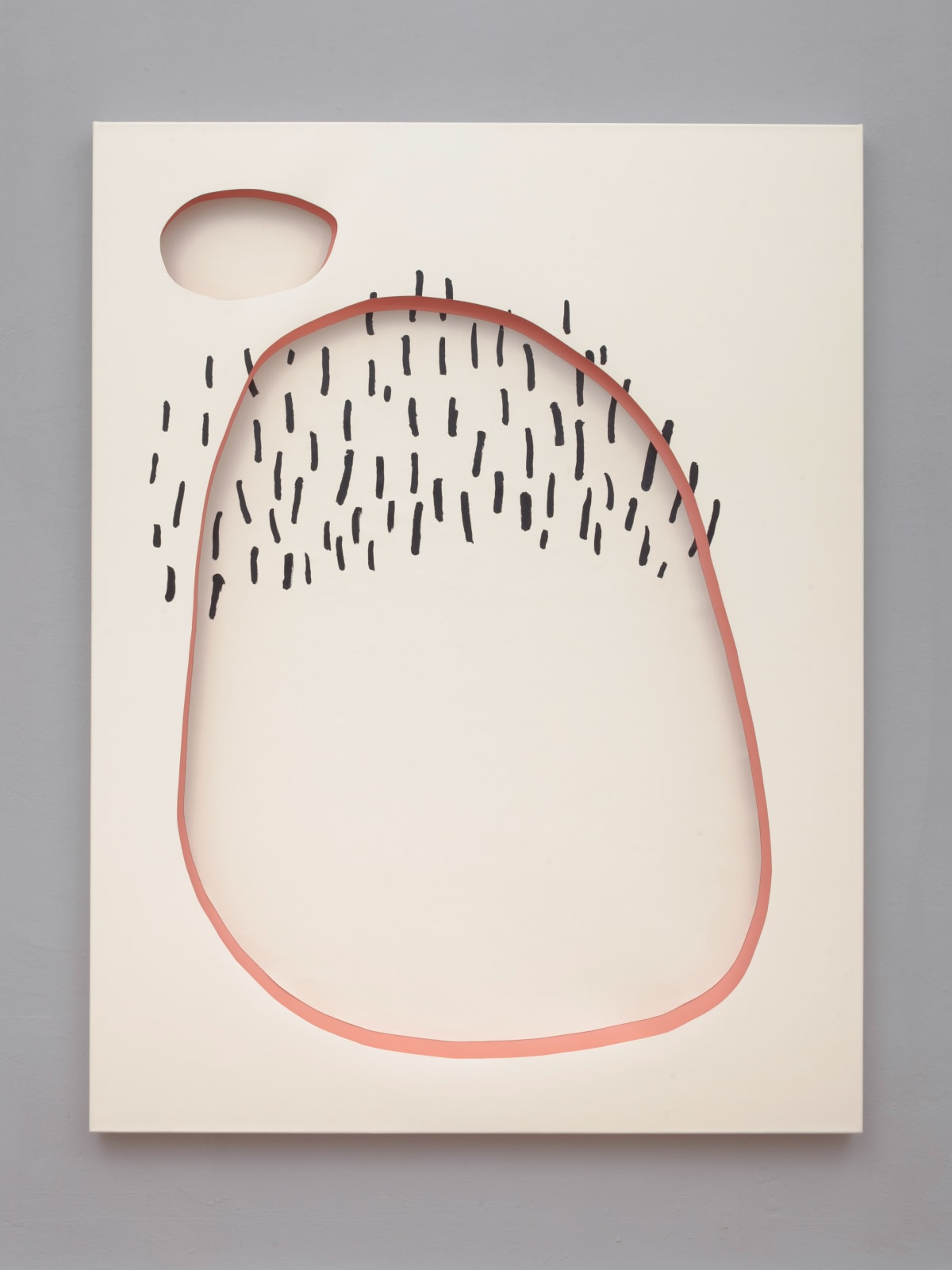

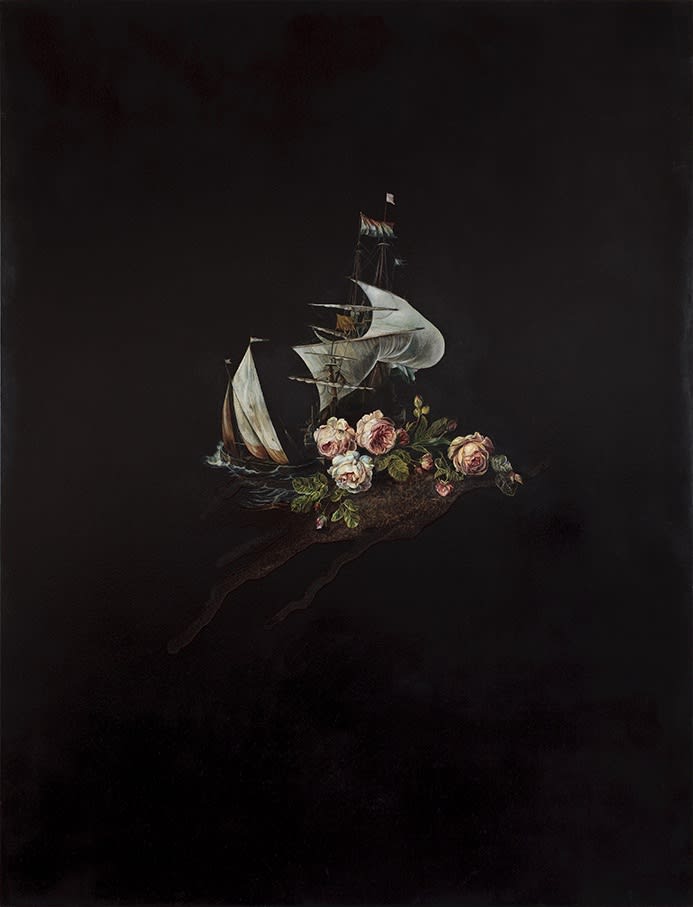



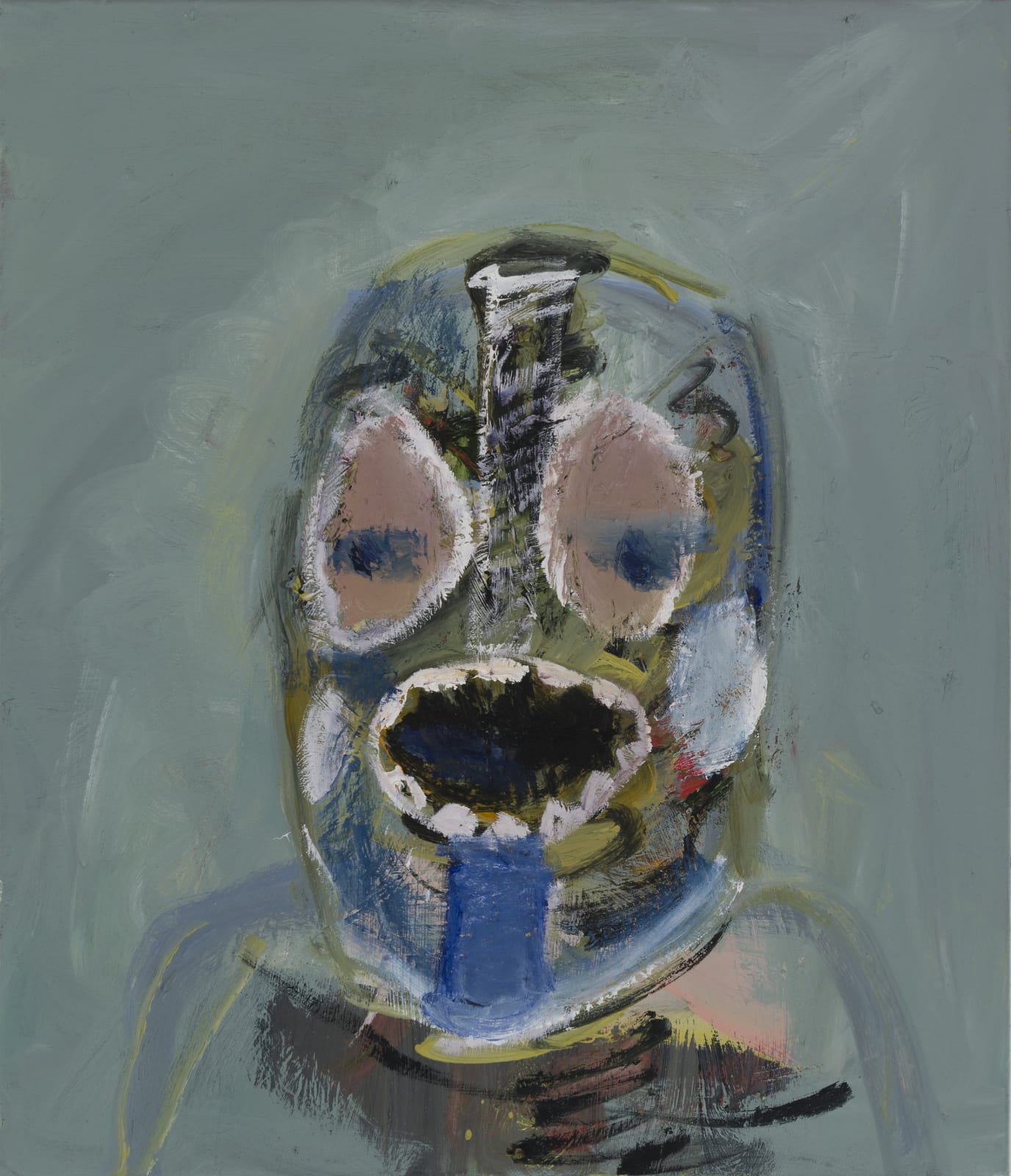



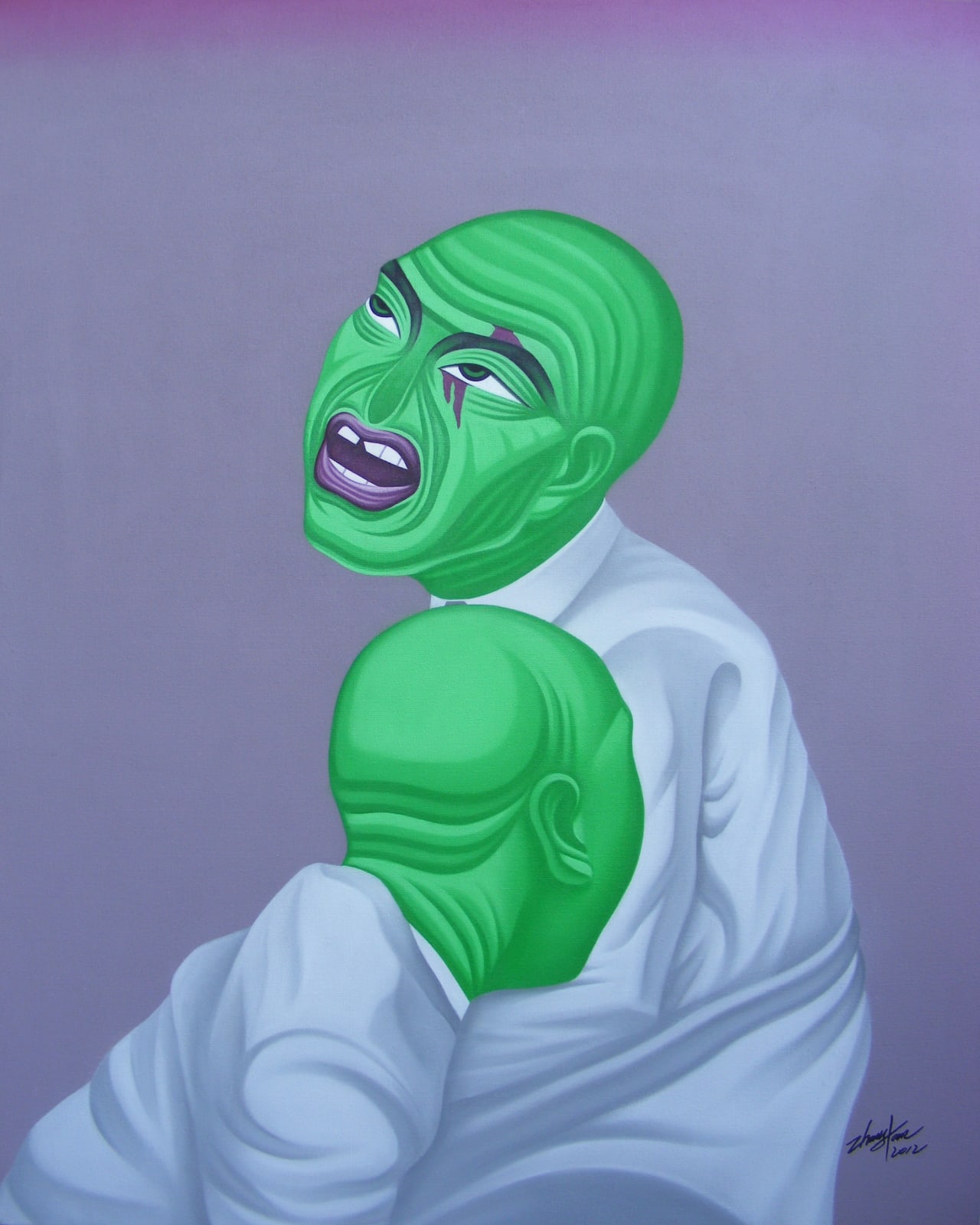



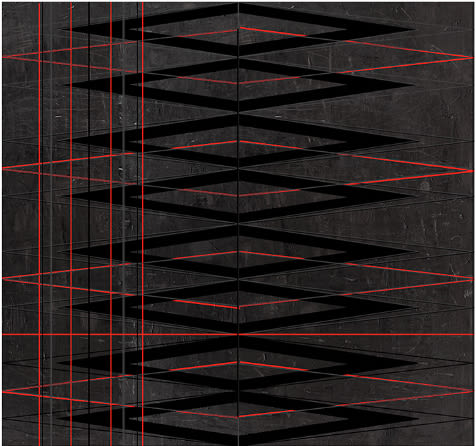







![GUILLERMO MORA, Gemelos [Twins], 2011](https://artlogic-res.cloudinary.com/w_1600,h_1600,c_limit,f_auto,fl_lossy,q_auto/ws-artlogicwebsite1666/usr/exhibitions/images/exhibitions/94/guillermo_mora_gemelos_2011.jpg)
